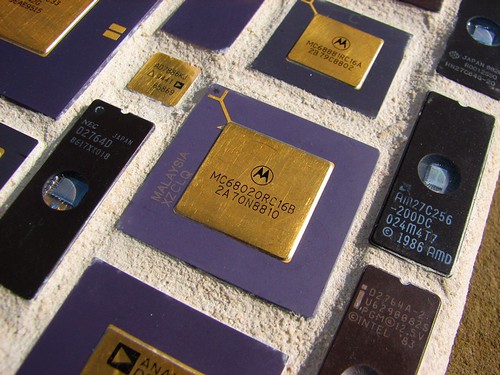
The integrated circuit (IC) is one of the most complex things ever made. They consist of small squares of silicon, imprinted with microscopic patterns. The patterns may contain hundreds of millions of transistors, resistors and other electronic parts. Inexpensive and ubiquitous, they power our PCs, cell phones, and music players. They make everything from toaster ovens to cars more efficient. As chip designers continue to improve the state of the art, they squeeze more functionality into ever-smaller packages.
Materials
Video of the Day
Integrated circuits are made of semiconducting materials, which are midway between good conductors, like copper, and insulators such as plastic. Silicon is the current favorite. Ultrapure silicon is mixed with small, precise amounts of other elements to create electronic materials with different characteristics.
Video of the Day
Packaging
The integrated circuit chip is too small and delicate to be handled directly. Each chip is bonded to a set of tiny gold or aluminum wires and set into a flat block of plastic or ceramic. The block has metal pins on the outside, leading to the wires inside. The pins form a solid mechanical and electrical connection to other components in a system. The plastic block protects the IC chip and helps keep it cool. The manufacturer name and part number is usually printed on the top.
ICs come in a variety of package types. Simple chips come in a dual-inline package, or DIP. These are long rectangles with four, seven, eight, or more pins on either side. As chip complexity has grown, designers have added more pins. Some microprocessor chips have hundreds of pins. These are arranged in neat rows on the bottom of the chip.
Size
The size of the actual integrated circuit chip varies from 1 square mm to more than 200. The plastic package that contains the chip is a few times larger. Its thickness can range from a fraction of a millimeter to a few millimeters.
Density
In 2009, transistors on some computer chips measure 45 nanometers (billionths of a meter) on a side. These chips have more than 100 million transistors. Since the 1960s, the semiconductor industry has managed to double the number of transistors on a chip every two years, a trend known as Moore's Law. As the transistor count goes up, so does the chip's functionality .
Integration
Discrete devices, like transistors and LEDs, are made of individual silicon chips. Integrated circuits get their name because they combine many different devices on the same chip. Since the transistors on a chip are so small, many sub-functions that used to be performed by many chips are now done by one. A microcontroller, for example, incorporates a complete microprocessor, memory and interface all in the same device.